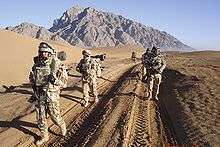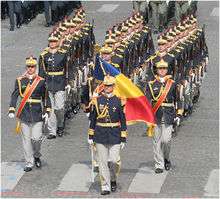Romanian Armed Forces
| Romanian Armed Forces Forțele Armate Române | |
|---|---|
|
The coat of arms | |
| Founded | 1860 |
| Current form | 11 April 2000 |
| Service branches |
|
| Headquarters | Bucharest |
| Leadership | |
| Supreme Commander of the Armed Forces | Klaus Iohannis |
| Minister of National Defence | Mihnea Motoc |
| Chief of the General Staff | General Nicolae Ionel Ciucă |
| Manpower | |
| Military age | 18 years of age |
| Conscription | No |
| Available for military service |
5,601,234 males, age 15–49 (2010 est.[1]), 5,428,939 females, age 15–49 (2010 est.[2]) |
| Fit for military service |
4,550,409 males, age 15–49 (2010 est.[3]), 4,507,880 females, age 15–49 (2010 est.[4]) |
| Reaching military age annually |
117,798 males (2010 est.[5]), 111,607 females (2010 est.[6]) |
| Active personnel | 84,480 (ranked 49th) |
| Reserve personnel | 84,145 |
| Deployed personnel |
2,187 (total)[7] |
| Expenditures | |
| Budget | €2.5 billion[8] |
| Percent of GDP | 1.4%[9] |
| Industry | |
| Domestic suppliers |
ROMARM Romtehnica Industria Aeronautică Română |
| Foreign suppliers |
Current: |
| Annual exports | €177,000,000 (2014)[10] |
| Related articles | |
| History | Military history of Romania |
| Ranks | Romanian Armed Forces ranks and insignia |
The Land Forces, Air Force and Naval Forces of Romania are collectively known as the Romanian Armed Forces (Romanian: Forțele Armate Române or Armata Română). The current Commander-in-chief is General Nicolae Ionel Ciuca who is managed by the Minister of National Defence while the president is the Supreme Commander of the Armed Forces during wartime.
90,000 men and women currently comprise the Armed Forces, 75,000 of them being military personnel and the other 15,000 civilians. Out of the 90,000 military and civilian personnel, 60,000 are the active troops (forțele active) while 30,000 comprise the active territorial reserves (forțele teritoriale).[11] As of 2010, the Land Forces have a reported strength of 43,000, the Air Force 9,700, the Naval Forces 7,150, and Joint Forces 13,500.[12] As per the 2011 White Paper, these forces are to be gradually decreased over the 2011-2014 period to reach a total of about 65,000 active troops and active reserves. Total defence spending currently accounts for 1.33% of total national GDP, which represents approximately 1.78 billion euros (ranked 54th).[13]
Equipment
The Land Forces have overhauled their equipment in recent years, and are today a modern army with multiple NATO capabilities. They are participating in a peacekeeping mission in Afghanistan, together with the other NATO countries. The Air Force currently operates modernized Soviet MiG-21 LanceR fighters, which are due to be replaced by modernized ex-Portuguese F-16 fighters by 2016. In the first stage a first squadron of 12 fighter aircraft will be acquired and a second squadron of another 12 aircraft [14][15] will follow by 2020. The Air Force has also received 7 new C-27J Spartan tactical airlift aircraft, in order to replace the bulk of the old transport force.[16] Two modernized ex-Royal Navy Type 22 frigates were acquired by the Naval Forces in 2004 and a further four modern missile corvettes will be commissioned in the next few years. Three domestically-produced IAR 330 Puma NAVAL helicopters were also ordered by the Naval Forces, and were commissioned in late 2008.
Manpower

Romania joined NATO in 2004. As a consequence, extensive preparations were made to abolish conscription by 2007 and create a professional army in place of a conscripted one.
The new armed forces include 90,000 men and women, of whom about 75,000 are military personnel (the remaining 15,000 or so are civilians). 60,000 of the 90,000 are active forces; 30,000 comprise the territorial forces.[17] Out of the 75,000 troops which comprise the actual military, about 45,800 make up the Romanian Land Forces, 13,250 serve as the Romanian Air Force and 6,800 are in the Romanian Naval Forces; the remaining 8,800 serve in other fields.[18]
Modernization
The Romanian Military will essentially undergo a three-stage restructuring. As of 2007, the first short-term stage has been completed. 2015 marks the end of the second stage when the armed forces will reach a superior compatibility with NATO forces.[19] In 2025, the long-term stage is to be completed. The stages aim at modernising the structure of the armed forces, reducing the personnel as well as acquiring newer and more improved technology that is compatible with NATO standards.[19]
Current deployments

Romanian troops participated in the occupation of Iraq, reaching a peak of 730 soldiers before being slowly drawn down to 350 soldiers. Romania terminated its mission in Iraq and withdrew its last troops on July 24, 2009.
Romania currently has troops deployed in Afghanistan, and is planning to nearly double its troop strength there to 1,800 by September 2010, according to an announcement made by President Traian Basescu in Prague on April 8, 2010.[20]
Other militarized institutions

The following Romanian institutions have military status but are not part of the Armed Forces:
- Romanian Gendarmerie (Jandarmeria Română), subordinated to the Ministry of Administration and Interior;
- Inspectoratul General al Corpului Pompierilor Militari (Military Firefighters) and Comandamentul Protecției Civile (Civil Defence), merged into the Romanian Inspectorate for Emergency Situations within the Ministry of the Interior;
- Serviciul Român de Informații (Romanian Intelligence Service);
- Serviciul de Protecție și Pază (Protection and Guard Service, provides protection to Romanian and foreign officials);
- Serviciul de Telecomunicații Speciale (Special Telecommunications Service);
- Serviciul de Informații Externe (Foreign Intelligence Service).
Military ranks
See also: Romanian Armed Forces ranks and insignia for the full insignia
Romanian Land Forces
Other ranks
- Soldat - Private (OR-2)
- Fruntas - Private First Class (OR-3)
- Caporal Clasa III - Corporal (OR-4)
- Caporal Clasa II - Corporal First Class (OR-4)
- Caporal Clasa I - Master Corporal (OR-4)
- Sergent - Sergeant (OR-5)
- Sergent-major - Staff Sergeant (OR-6)
- Plutonier - Sergeant First Class (OR-7)
- Plutonier-major - Master Sergeant (OR-8)
- Plutonier adjutant - Sergeant Major (OR-9)
- Plutonier adjutant principal - Command Sergeant Major (OR-9)
Specialists
- Maistru militar clasa 5 - Sergeant (OR-5)
- Maistru militar clasa 4 - Staff Sergeant OR-6)
- Maistru militar clasa 3 - Sergeant First Class (OR-7)
- Maistru militar clasa 2 - Master Sergeant (OR-8)
- Maistru militar clasa 1 - Sergeant Major (OR-9)
- Maistru militar principal - Command Sergeant Major (OR-9)
Officers
- Sublocotenent - Second lieutenant (Sub-lieutenant) (OF-1)
- Locotenent- First lieutenant (Lieutenant) (OF-2)
- Căpitan - Captain(OF-3)
- Maior - Major (OF-4)
- Locotenent-colonel - Lieutenant colonel (OF-5)
- Colonel - Colonel (OF-6)
General Officers
- General de brigadă - Brigadier General (OF-7)
- General-maior (General de divizie) - Major General (Divisional General) (OF-8)
- General-locotenent (General de corp de armata) - Lieutenant General (Corps General) (OF-9)
- General - (General de armata) - General (General of the Army) (OF-10)
Marshals
- Mareșal - Marshal (Appointed only in war time)
No longer used:
- Locotenent-maior - Senior lieutenant (OF-2b)
- General-colonel - Colonel general (OF-9)
Romanian Air Forces
Other ranks
- Soldat - Airman
- Fruntas - Airman First Class
- Caporal clasa III - Corporal
- Caporal clasa II - Corporal First Class
- Caporal clasa I principal - Master Corporal
- Sergent - Staff Sergeant
- Sergent-major - Technical Sergeant
- Plutonier - Master Sergeant
- Plutonier-major - Senior Master Sergeant
- Plutonier adjutant - Chief Master Sergeant
- Plutonier adjutant principal - Command Chief Master Sergeant
Specialists
- Maistru militar clase 5 - Staff Sergeant
- Maistru militar clase 4 - Technical Sergeant
- Maistru militar clase 3 - Master Sergeant
- Maistru militar clase 2 - Senior Master Sergeant
- Maistru militar clase 1 - Chief Master Sergeant
- Maistru militar principal - Command Chief Master Sergeant
Officers
Note that those in parentheses are ranks formerly used (stated in italic) or former rank names or literal rank meanings.
- Sublocotenent - Sub-lieutenant
- Locotenent- Lieutenant
- (Locotenent-major) - First lieutenant
- Căpitan - Captain
- Locotenent-comandor - Major (Lieutenant-commodore)
- Căpitan-comandor - Lieutenant colonel (Captain-commodore)
- Comandor - Colonel - (Air Commodore)
- General de flotilă aeriană - Brigadier General (Air Flotilla General)
- General-maior (General de divizie aeriană) - Major General (Air Divisional General)
- General-locotenent (General comandor) - Lieutenant General (Commander General)
- General - General
- (General de armata) - General of the Air Force
Romanian Naval Forces
Naval Ratings
- Soldat - Seaman Recruit
- Fruntas - Seaman Apprentice
- Caporal clasa III - Seaman
- Caporal clasa II - Seaman First Class
- Caporal clasa I principal - Master Seaman
- Sergent - Petty Officer Second Class
- Sergent-major - Petty Officer First Class
- Plutonier - Chief Petty Officer
- Plutonier-major - Senior Chief Petty Officer
- Plutonier adjutant - Master Chief Petty Officer
- Plutonier adjutant principal - Command Master Chief Petty Officer
- Maistru militar clase 5 - Petty Officer Second Class
- Maistru militar clase 4 - Petty Officer First Class
- Maistru militar clase 3 - Chief Petty Officer
- Maistru militar clase 2 - Senior Chief Petty Officer
- Maistru militar clase 1 - Master Chief Petty Officer
- Maistru militar principal - Command Master Chief Petty Officer
Officers
Note that those in parentheses are ranks formerly used (as stated) or former rank names or literal rank meanings.
- Aspirant - Ensign (Aspirant)
- Locotenent- Lieutenant (junior grade) (Lieutenant)
- (Locotenent-major) - Second lieutenant
- Căpitan - Lieutenant (Captain)
- (Căpitan-locotenent) - Captain lieutenant
- Locotenent-comandor (Căpitan de rangul III) - Lieutenant Commander (Lieutenant-commodore)
- Căpitan-comandor (Căpitan de rangul II) - Commander (Captain-commodore)
- Comandor (Căpitan de rangul I) - Captain - (Commodore)
- Contraamiral de flotilă - Commodore (Flotilla Counter Admiral)
- Contraamiral - Rear Admiral (Counter admiral)
- Amiral - Admiral
See also
- List of the Chiefs of the General Staff of Romania
- List of countries by number of active troops
- Foreign relations of Romania
- Equipment of the Romanian Armed Forces
- Romanian Air Force
- Romanian Naval Forces
Notes
- ↑ CIA World Factbook, Military of Romania
- ↑ CIA World Factbook, Military of Romania
- ↑ CIA World Factbook, Military of Romania
- ↑ CIA World Factbook, Military of Romania
- ↑ CIA World Factbook, Military of Romania
- ↑ CIA World Factbook, Military of Romania
- ↑ Romanian General Staff Data, November 2011
- ↑ "2016 | Bugetul Apărării: 2,5 miliarde de euro". Retrieved 27 July 2016.
- ↑ "Romania aloca mai multi bani pentru Aparare in 2016. Planul de echipare a Armatei". Retrieved 27 July 2016.
- ↑ Romanian armament exports doubled Gandul, 13 January 2015.
- ↑ (Romanian) Ministry of National Defence. Press conference
- ↑ IISS Military Balance 2010.
- ↑ (Romanian), December 5, 2011
- ↑ http://www.romania-insider.com/romania-wants-to-buy-more-f-16s/165568/
- ↑ http://www.airforce-technology.com/news/newsromania-to-acquire-f-16-fighter-jets-4821598[]
- ↑ "Spartan Order", Aviation Week & Space Technology, December 11, 2006.
- ↑ Ministry of National Defence, Press conference
- ↑ Adevărul, România, cel mai important dintre viitorii membri ai NATO ("Romania, the most important among the future NATO members"), November 20, 2002
- 1 2 Ministry of National Defence, Strategia de transformare a Armatei României ("Strategy for the transformation of the Romanian Army")
- ↑ YAHOO News, WHITE HOUSE NOTEBOOK: Obama in Prague
Further reading
- Daniel N. Nelson, 'Armies, Security, and Democracy in Southeastern Europe,' Armed Forces & Society, Vol. 28, No.3, Spring 2002.
External links
| Wikimedia Commons has media related to Military of Romania. |
- (English) Official site of the Romanian Ministry of Defence (MoD)
- (English) Official site of the Romanian General Staff
- (English) Official site of the Romanian Land Forces
- (English) Official site of the Romanian Air Force
- (English) Official site of the Romanian Naval Forces
- New U.S. Base in Romania To Be Larger Than Previously Estimated, ThePeacockReport.com, Oct. 11, 2006.


